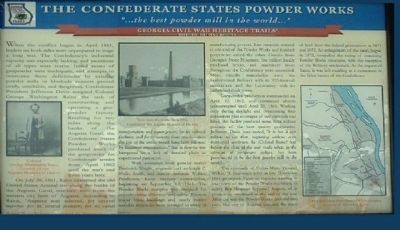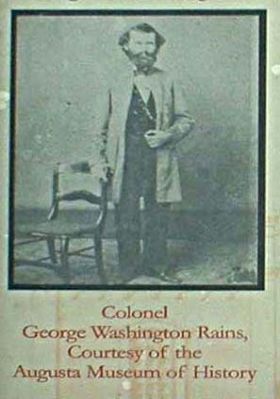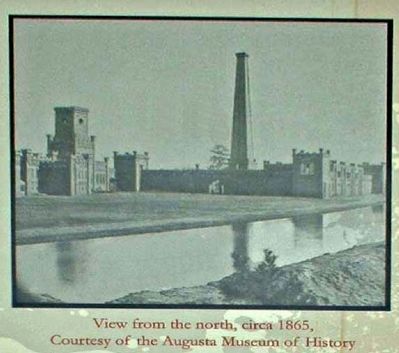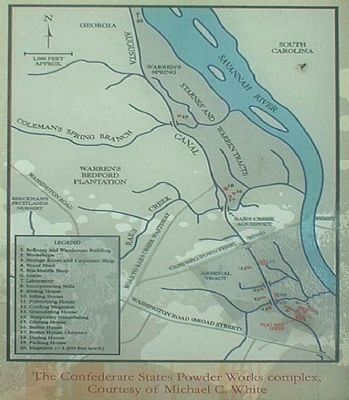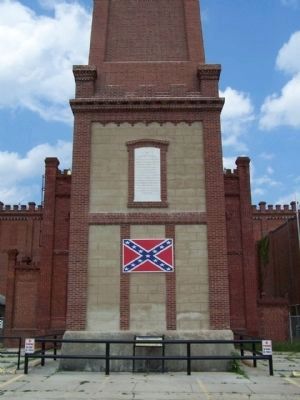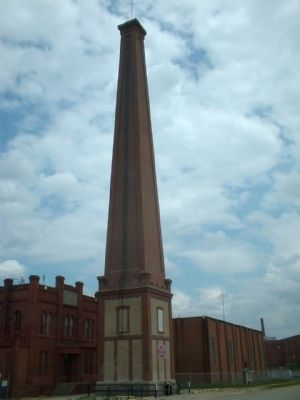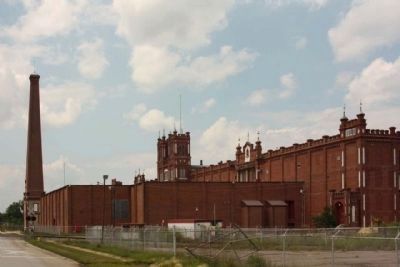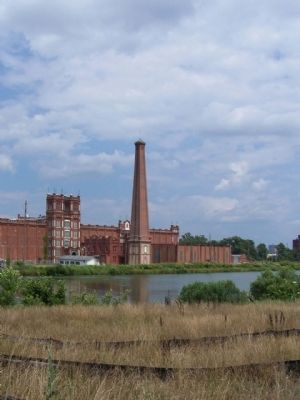Augusta in Richmond County, Georgia — The American South (South Atlantic)
The Confederate States Powder Works
"...the best powder mill in the world..."
When the conflict began in April 1861, leaders on both sides were unprepared to wage a long war. The Confederacy's industrial capacity was especially lacking, and munitions of all types were scarce. Initial stores of gunpowder were inadequate, and attempts to overcome these deficiencies by existing powder mills or blockade runners proved costly, unreliable and dangerous. Confederate President Jefferson Davis assigned Colonel George Washington Rains the task of constructing and operating a gun powder factory. Reaching for two miles along the banks of the Augusta Canal, the Confederate States Powder Works produced much of the gunpowder for Confederate Armies from April 1862 until the war's end three years later.(Picture included: Colonel George Washington Rains)
On July 20, 1861, Rains examined the old United States Arsenal site along the banks of the Augusta Canal, one half mile from the western city limit of Augusta. According to Rains," Augusta was selected, for several reasons: for its central position; for its canal transportation and water power; for its railroad facilities; and for its security from attack- since the loss of the works would have been followed by disastrous consequences." But at first he was hampered by a lack of detailed plans or experienced personnel.(Picture included: Complex view from the north)
With the assistance from powder maker Frederick Wright, engineer and architect C. Shaler Smith, and master mechanic William Pendleton, Rains oversaw construction, beginning on September 13, 1861. The Powder Works complex was designed for manufacturing efficiency and safety. Thirteen major brick buildings and nearly twenty wooden structures were arranged in order of manufacturing process. Raw materials entered at one end of the Powder Works and finished gunpowder exited the other. Granite from Georgia's Stone Mountain, five million locally produced bricks, and machinery from throughout the Confederacy were assembled. Most visually remarkable were the battlemented Refinery with its 153-foot-tall smokestack and the Laboratory with its unfinished clock tower.
Gunpowder production commenced on April 10, 1862, and continued almost uninterrupted until April 29, 1865. Working only during daylight and overcoming four explosions plus shortages of raw materials and labor, the facility produced some three million pounds of the best quality gunpowder. Jefferson Davis later noted, "it is but a just tribute to say that, beginning without even instructed workmen, he [Colonel Rains] had before the close of the war made what, in the opinion of competent judges, has been pronounced to be the
best powder
mill in the world...."
The approach of Union Major General William T. Sherman's army in late November 1864 prompted Rains to consider moving at least some of the Powder Works machinery to safety. But Sherman bypassed Augusta while production continued to the end of the war. After the war the Powder Works declined into ruin. The city of Augusta acquired the tracts of land from the federal government in 1871 and 1872. An enlargement of the canal, begun in 1872, compelled the razing of remaining Powder Works structures, with the exception of the Refinery smokestack. At the request of Rains, it was left standing as a monument to the fallen heroes of the Confederacy. (Complex map included)
Erected by Georgia Civil War Heritage Trails. (Marker Number L23.)
Topics and series. This historical marker is listed in these topic lists: Industry & Commerce • Military • Notable Buildings • War, US Civil. In addition, it is included in the Georgia Civil War Trails series list. A significant historical month for this entry is April 1861.
Location. 33° 29.221′ N, 81° 59.545′ W. Marker is in Augusta, Georgia, in Richmond County. Marker is on Goodrich Street, on the right when traveling north. Located between Kendrick Place and Eve Street.
Touch for map. Marker is in this post office area: Augusta GA 30904, United States of America. Touch for directions.
Other nearby markers. At least 8 other markers are within walking distance of this marker. Confederate Obelisk-Chimney (here, next to this marker); Explosion At The Confederate Powder Works (about 600 feet away, measured in a direct line); White House Tract (approx. 0.2 miles away); Confederate Powder Works (approx. ¼ mile away); Crossroads of the Southeast (approx. 0.3 miles away in South Carolina); The Power of the Savannah River (approx. half a mile away in South Carolina); Boeckh Park (approx. 0.6 miles away in South Carolina); Riverfront Village (approx. 0.7 miles away in South Carolina). Touch for a list and map of all markers in Augusta.
Also see . . . Sibley Mill and Confederate Powder Works Chimney. National Park Service entry:
Work on the plant commenced in 1862 with materials gathered from the southern states including Georgia, Alabama, Tennessee, Virginia, and North Carolina... (Submitted on July 11, 2010, by Mike Stroud of Bluffton, South Carolina.)
Credits. This page was last revised on March 16, 2021. It was originally submitted on July 11, 2010, by Mike Stroud of Bluffton, South Carolina. This page has been viewed 2,111 times since then and 62 times this year. Photos: 1, 2, 3, 4, 5, 6, 7, 8. submitted on July 11, 2010, by Mike Stroud of Bluffton, South Carolina.
